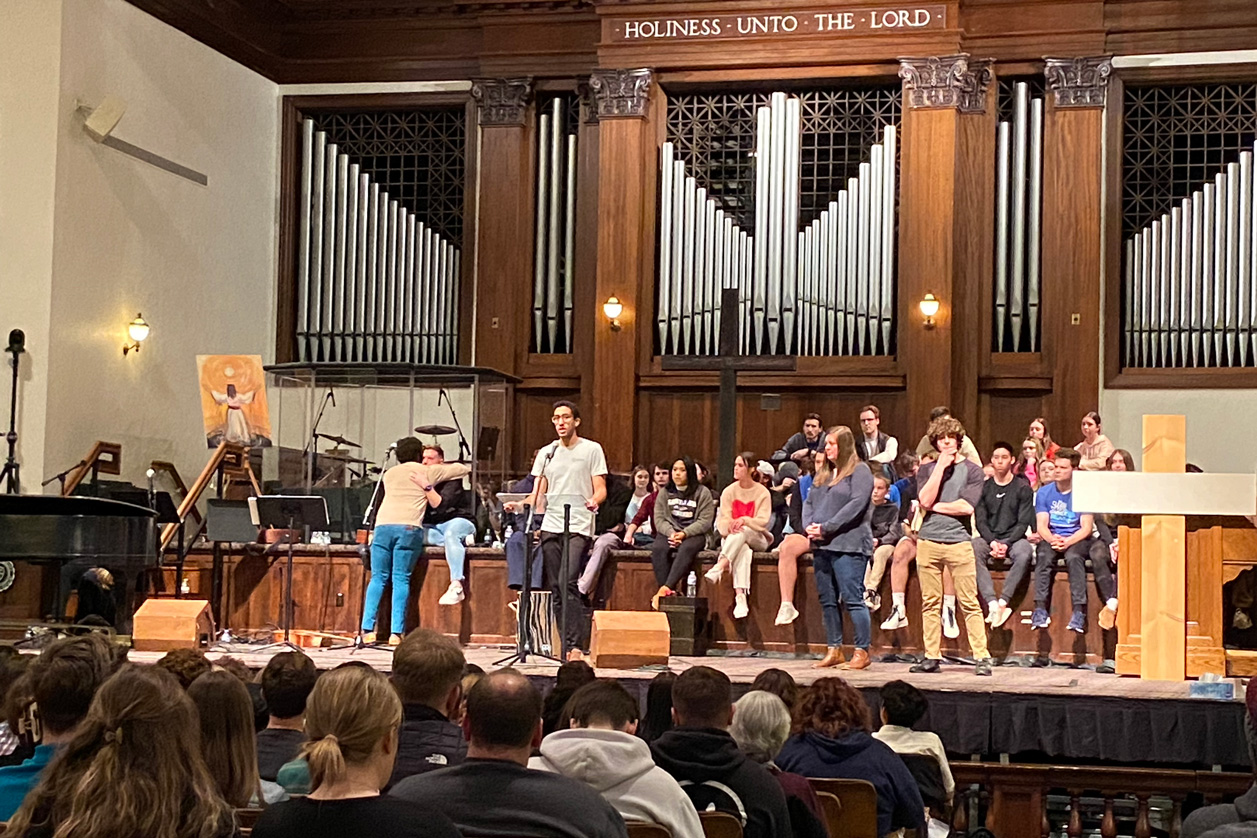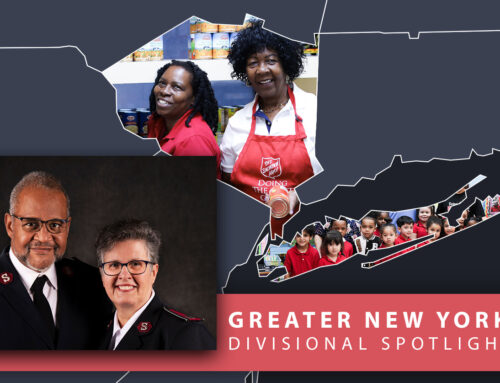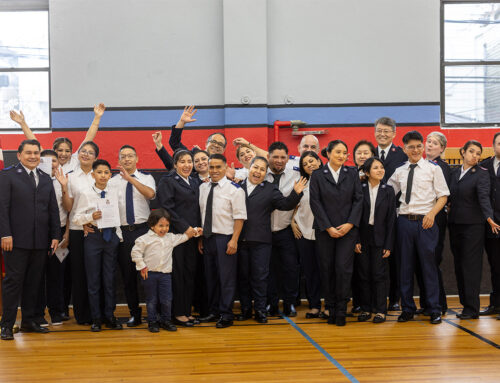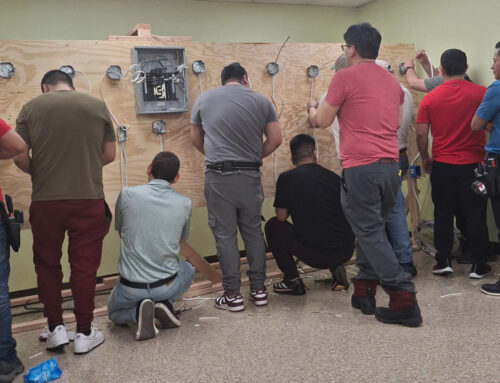
Another Great Awakening?
by Robert Mitchell
“A revival is the intensification and acceleration of the normal Christian life.”
—Jonathan Edwards.
The revival fires of the Second Great Awakening broke out in Kentucky in the early 1800s and another movement of the Holy Spirit began on February 8 at Asbury College in Wilmore, Ky. The revival wound down over President’s Day Weekend, but those involved hope the blaze keeps burning.
“The Salvation Army is fully engaged in what is happening,” Major Paul Cain, who co-leads The Salvation Army Student Fellowship (SASF) at Asbury, said at the height of the revival. “It’s definitely Holy Spirit-led. The presence of the Holy Spirit and the feeling of the presence of God is palpable.”
How did it start?
Students at Asbury, a Methodist college with an almost century-long partnership with The Salvation Army, are required to attend chapel at 10 a.m. every Monday, Wednesday, and Friday.
The chapel service on February 8 was itself uneventful and featured no special revival speaker, music, or emphasis. However, after the 11 a.m. dismissal, the praise band kept playing and about 20 students stayed behind to pray.
Cain said the remaining students soon began texting others to return to Hughes Auditorium for more praise, worship, testimonies, prayer, and speakers. By early afternoon, a couple hundred students had returned and a few hours later about 1,000 people had crowded into the auditorium.
The revival continued nonstop—day and night with new musicians and speakers—before the college announced that the outpouring would close to the public on February 24. At its zenith, there were long lines to get into Hughes, which can hold 1,500. The movement also spread to multiple satellite locations on campus and even several area colleges.
“It’s been amazing,” Cain said. “As word began to get out, more and more people started to come to campus, especially in this day of social media.”
God does the moving
The revival also took over the internet (a recent livestream of the regular chapel service drew 6.5 million people) with evangelicals of all stripes posting video clips and debating on social media if the revival was real. Cain has seen those debates and said he’s a believer.
“When you walk into Hughes Auditorium and you begin to consider what is happening around you, and you see people moving freely to the altar and generously praising God, you also see college students not on their phones,” he said. “Instead, you see them raising their hands and praising the Lord in the peaceful presence of God. You’re transformed in the moment. All one needs to do is be in the presence of God and you’re in a revival.
“It’s amazing because you walk in and there’s no flashy entertainment, no program, order of worship. It’s just as the Holy Spirit leads.”
Cain said Brigadier Clifton Sipley, a Salvationist luminary, taught him many years ago that when it comes to revival, God decides when and where and how they manifest.
“That has certainly been evident here,” Cain said. “There’s nothing special about Asbury or this administration or this group of students, but what is special is the presence of God. That God has chosen this place and this time is totally God’s will and design. We’re just here to bask in the glory of it.”
Many students in the SASF, which has a building on campus, attended the revival services and played prominent roles.
Reed Brunell, a senior from Ocean County, N.J, said she remembers attending a chapel service about the 1970 Asbury revival on the event’s 50-year anniversary in 2020. She believes the current awakening is a real movement of God.
“Because it’s been going on for so long now, a lot of people feel that if God weren’t here, it would have gone away already,” she said. “If God weren’t moving, it wouldn’t still be going. But it is still going, and God is still moving, and people are still coming. That’s a really powerful thing.”
Emotional testimonies
Brunell, the vice president of the SASF at Asbury, came to the revival after an emotional day of working for a refugee agency dealing with people from the Ukraine, Democratic Republic of the Congo, Afghanistan, Syria, and Turkey who are trying to adjust to a new country. The speakers at the podium were praying for Syria and Turkey when she arrived.
“They were praying and it just hit,” she said. “I just felt like this rush of release come out of me because there are people who care that this is going on. I cried so much.”
Senior Jena Pelletier, a sociology major, is excused from chapel this semester so she can do an internship at a refugee agency. She got an email on February 8 telling her about the revival. She got back to Hughes Auditorium at about 8 p.m. and said it was “pretty full” of students.
“I definitely felt the Holy Spirit and His presence the last few days being in that space, but I would describe it more as a deep peace and a deep groundedness in watching the body of Christ come together and people come from so many different places near and far to bear witness to the revival that is going on,” she said.
Pelletier, whose officer parents are stationed in Worcester, Mass., said her professors have taken an interest in studying the revival from a sociological standpoint. She mentioned “collective effervescence,” which she equated to the unity people share at a sporting event with clapping and cheering. That can sometimes bleed over into church environments, but she doesn’t see that here.
“All I can think about it is this just really is the Lord,” she said. “In this setting right now, I 100 percent believe it’s the Holy Spirit.”
Sleeping at the revival
Ashlie Pelletier, a freshman at Asbury and Jena’s sister, also got an email about the revival and returned about 2 p.m. on February 8.
“You literally felt the Spirit as you walked in,” she said. “It was incredible. The worship was very strong. That just continued into the night.”
Some of her friends dragged their mattresses from home to stay the night at Hughes Auditorium. Ashlie herself stayed until 4 a.m. one morning in the early days, even though she had a class in just four hours.
“The worship has been great, but the amount of prayer that has gone into this has been impressive,” she said. “I do know that this revival is spreading and continually growing. It’s definitely God’s work. It’s real.”
Envoys Steve and Sharon Bussey, who are stationed in West Nyack, N.Y., asked for personal time off and drove to Wilmore to see the revival for themselves. Steve Bussey, an avid student of church history, says the comparisons between the famous 1970 Asbury Revival (see below) and this one are “uncanny.”
“Without question, this is a 100 percent, legitimate, historic revival,” Steve said. “I’m sitting out here looking at a line of people in the middle of the day that has not stopped of people wanting to go into church. It’s the real deal. We just came here to experience the Lord.”
Seeing is believing
The Busseys have worked on the USA Eastern Territory’s “Together With One Accord” campaign since 2021. “We envision an Army united in purpose and actively pursuing God’s next Great Awakening,” the campaign says. The focus is to bring The Salvation Army together through empowering, encouraging, equipping, and engaging.
Steve, like Cain, was struck by the fact that nothing extraordinary kicked off the revival—no celebrity speaker and “a lack of anything dramatic or wild or architected by humans.”
“It’s a radical normalcy,” Steve said, noting that many of the worship songs from the revival were the same as he sings back in Spring Valley, N.Y. “What we’re seeing here is without question an intensification and acceleration of what should be normal, but which is sadly and grossly missing from our society today. That’s what I think is so incredible.
“As a person who is a fan of church history, I’m sitting here saying this is what I know abstractly from reading history, but I’ve never seen it quite like this is my generation. To me, that is really what is screaming out here.”
Sharon said God is “speaking to the next generation” at Asbury, particularly the wounded youngsters of Generation Z (born 1997-2012). She said she witnessed emotional healing in a “genuine and quiet way, in a way that is restoring a sense of identity to a younger generation.”
“I got a sense that God is speaking very specifically to this generation about His loving presence, a loving father who is there,” she said. “As Christians, we believe that God is not only holy, but he is holy love. I think the starting point where God seems to be connecting with this generation is that point of love first and then showing them His holiness.
“Something is happening with Generation Z. I think God is awakening this generation for something very important.”
What now?
Steve agreed with his wife about the generational message.
“I’ve found how God is breaking our hearts for this next generation and how God needs to break our hearts with holy love,” Steve said through tears. “I’m not an emotional guy, but you can’t help it. There is a sense of the presence of God here that the reports don’t do it justice. You can feel it.”
The Busseys were also struck by the preaching, teaching, and call for repentance and salvation.
“That’s a key,” Sharon said. “Every revival starts with repentance because we need to recognize our need for God first.”
Brunell, like many others at Asbury, sees the revival having lasting impacts and leading to changes like the first and second great awakenings.
“God works in mysterious ways and although what’s happening at Hughes can’t sustainably last the way it is, I’m convinced God is still going to move afterward and He’s going to continue to move in people’s lives,” she said.
Cain’s wife, Major Alma Cain, who co-leads the SASF, is another one waiting to see the results of the revival.
“I have seen the look on the faces of people as they arrive and are brought into the presence of the Lord,” she wrote on social media. “I have been changed. How could you be here and not stand in the river of blessing and not ask to be or want to be changed?
“I am overwhelmed by what God has already done. I am waiting, along with my friends here, for what God will continue to do.”
-
First Great Awakening
Led by such figures as Jonathan Edwards, George Whitefield, and John Wesley, the First Great Awakening was a series of revivals from the 1730s to the 1770s in Europe and the English colonies of North America. America’s religious faith had grown stale. The zeal of the 17th Century Puritans who first came to America was gone and a general malaise about the things of God had settled in. Strong biblical preaching, prayer, and fasting were keys to the revivals. The result was a newfound enthusiasm for Christianity and religion.
-
Second Great Awakening
The Second Great Awakening lasted from the turn of the century to the 1830s. One of the places that saw revival was the Red River Meeting House in rural Kentucky, where an area known as “Satan’s Stronghold” birthed “Southern hospitality” because of the revivals. The awakening led to camp meetings, circuit riders, improved race relations, women’s suffrage, the explosion of missionary work, the temperance movement, and the growth of black Protestantism. This all had a profound influence on early Salvationists.
-
The Salvation Army revival, 1878-1883
This six-year period was halcyon days for The Salvation Army, which saw a mini-revival. In 1878, The Christian Mission officially became The Salvation Army. A year later, 16-year-old Eliza Shirley arrives in Philadelphia to start the work there and The Salvation Army’s first brass band begins. In 1880, The Salvation Army arrived in America and began publishing periodicals, including the American War Cry.
-
Asbury University revival, 1970
In February 1970, Dean Custer Reynolds, instead of speaking in chapel, wad led to allow people to share their testimonies. The Holy Spirit soon moved, and many waited in line for their turn. The revival spirit engulfed the campus, leading to classes being canceled for a week and teams of students going out to witness in the community and other college campuses.




